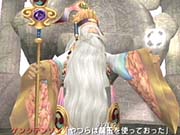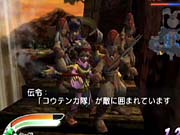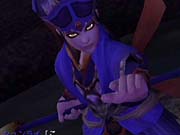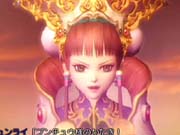Mystic Heroes Hands-on
The creators of the popular Dynasty Warriors franchise takes the beat-'em-up to the next level in this melee action game for the GameCube.
It's hard to argue against the Dynasty Warriors formula. While it may seem like a repetitive hack-and-slash game from the old-school days of video games, it's gameplay is deep enough to snare you in and not let go until the game is complete. This is evidenced by the sales of the franchise, which have gone into the millions between both the Japanese and North American markets. Koei is hoping to replicate the same success it's enjoyed with Dynasty Warriors on the PlayStation 2 with Mystic Heroes, a story-driven melee action game for the GameCube.

Called Battle Houshin in Japan, Mystic Heroes asks you to play as one of four characters while trying to stop an evil ruler from regaining his throne. Shiga, Lani, Naja, and Tai are called to duty by a mystic elder named Master Gen when the exiled leader, Emperor Kang, begins conjuring up armies of the dead with a mythical item called the dragon star. The foursome must hack its way through hordes of enemies while ascending Mountain Houshin and attempt to take the magical stone from Emperor Kang so he will no longer have the ability to revive his fallen army.
When many people think of hack-and-slash games, the first thing that comes to mind is repetitive gameplay. While this can be the case with Mystic Heroes at times, four playable characters and a multitude of magical attacks help to keep things interesting. Each of the four characters is imbued with a particular elemental rating such as fire and lightning and has two slots to equip weapons and spells. Spells and weapons also follow this elemental rating system, and matching your weapons or spells with your character's elemental configuration will make your character more powerful than if you try to mix them up. When you begin the game your character will be relatively weak, but as you defeat enemies, complete levels, and defeat bosses your character's attributes will be increased, allowing for more elaborate and devastating attacks and magic spells. You can select whichever weapons and spells you want to equip your character with before each level begins, and it can be fun to see how your character's powers are changed depending upon what's equipped. By the time you've reached the end of the game there will be scores of spells and weapons to choose from, and intelligently setting up your character for each level eventually becomes a necessity.
Actually playing the game is fairly easy to come to grips with. The analog stick controls your character, and the A button performs melee attacks. Pressing the A button repeatedly will cause your character to perform combos that can be used to juggle enemies. Performing combos is probably the easiest way to build up your character's attributes, and it's easy to rack up huge combo totals while using it. While you can simply mash on the A button and perform adequately, there are many advanced techniques for hand-to-hand combat. Rotating the analog stick in a circle will cause your character to perform a spinning sword slash, tapping forward and attack at the same time will cause your character to perform a shoulder charge, and the R button in conjunction with the analog stick will make your character roll to evade attacks. The R button can also be used to block attacks, and common melee tactics like the jumping downward slash are also a part of the gameplay.

To perform magic, you must first build up your magic-points meter by attacking enemies. Magic is then performed by pressing either the X or Y button, and between levels you can choose which spells you'd like mapped to the buttons. However, the actual visual imagery for the spells remains the same regardless of which spell you choose, though the way the attacks work and their relative effectiveness is altered. Magic attacks can be used in a variety of ways. You can tap the X button to power up your melee weapon and then start pressing the A button to use it, or you can press the X button after jumping to perform airborne magical attacks. This is the easiest way to accumulate huge combo totals, as you can lure hordes of enemies into one area and then take them all out with one spell. The Y button is reserved for projectile attacks, but there are two ways to perform them. Simply tapping the Y button will cause your character to send out a ground-based projectile that will take out more enemies as your character's attributes increase. You can also hold the Y button, which will cause the camera to go into a first-person mode where you can aim your projectile and release the button to fire. When your character becomes stronger, your projectile attacks will eventually have homing abilities.
There are eight levels in the game and what seems like more than 20 different boss fights to tackle. Each level is split into a few missions, and you're able to save the game after each one. The levels are flooded with enemies, and normally the objective is to destroy every last one and then a door will open providing a new path to take. There are some very light puzzle elements later on in the game, but they normally revolve around finding a switch and hacking it with your sword. While playing the normal conquest mode you'll have several allied characters fighting alongside you. As the game progresses, characters continually join your cause until you reach the point that there are 20 characters in your party all fighting together in some levels. However, their attacks are very weak, and they serve only to preoccupy the enemies while you go about your work. Though it's tempting to try to protect them from enemies, allied characters never seem to die regardless of how inept you are at protecting them. The game also includes a survival mode for those who simply want to hone their combat skills, and certain weapons and spells can only be found by playing through it.

Mystic Heroes is Koei's first GameCube game, and it shows in the graphics. The game's visual presentation relies heavily on polygonal output instead of creating beautiful environments. But with this said, there are still graphical aspects worth getting excited about. Aside from the bosses, the enemies in the game come in only a handful of varieties, with each having its own battle tendencies and abilities. Each enemy is constructed of a healthy number of polygons and manages to avoid looking like it was pulled from a Nintendo 64 game. When you take into account that upward of 70 of them will be onscreen at once, then the graphics in Mystic Heroes suddenly become a bit more impressive.
All the more impressive is the fact that the frame rates never slow down. This is, in part, the product of the horizon being fogged out so that the hardware isn't drawing a great deal of terrain. And the terrain that is visible isn't exactly gorgeous. Low-resolution, blurry textures cover the game's environments and give the visual presentation an overall soft look. However, the graphics for spells can be quite good and will take up the entire screen. The camera angles in particular are quite effective at conveying the action--especially when your character takes flight for an airborne magical attack. You'll be able to look down on the hordes of enemies and then send your magical attack down to earth to take them all out at once. As you might expect, the animation routines for the enemies can be simple and repetitive, but when there are scores of them onscreen at once it's not quite as noticeable. The character design and settings in the game are very Japanese, so expect plenty of funky hairdos, a multitude of dojo-type settings, and huge, anime-inspired eyes. The game predominantly uses real-time cinemas to move the plot along, but there are plenty of FMV sequences as well. Mystic Heroes is a story-driven game, and therefore there are cinemas that occur after every minor event in the game. In all, Koei has done an admiral job with the visuals in Mystic Heroes, but fewer enemies and prettier environments would have given it more appeal to the average player.

Mystic Heroes is an average-looking game that has surprisingly deep gameplay. The melee combat is fun, if a bit repetitive, but the magic and the ability to customize your character's abilities make playing the game addictive. With a multitude of enemies attacking constantly, the pacing of the game never lets up, and the plot is just enough to keep players glued to the couch. Like with the Dynasty Warriors franchise, Koei may have a sleeper hit on its hands when Mystic Heroes ships to retailers in September. We'll have more on the game when we receive a localized build.
Got a news tip or want to contact us directly? Email news@gamespot.com
Join the conversation